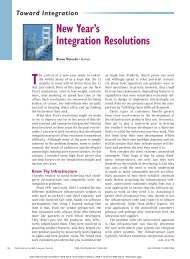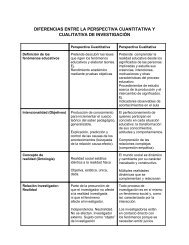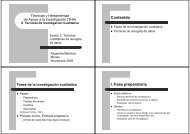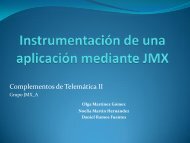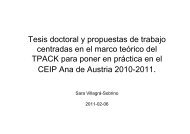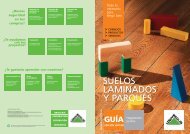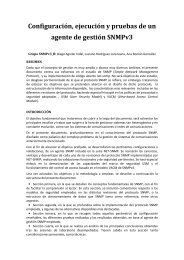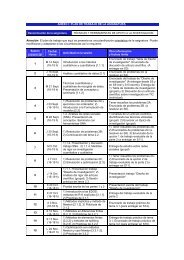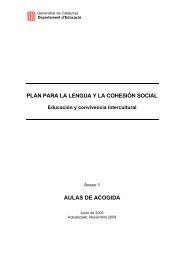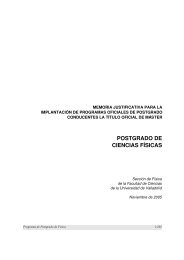Research Questions and Hypotheses
Research Questions and Hypotheses
Research Questions and Hypotheses
Create successful ePaper yourself
Turn your PDF publications into a flip-book with our unique Google optimized e-Paper software.
140 Designing <strong>Research</strong><br />
<strong>Research</strong> <strong>Questions</strong> <strong>and</strong> <strong>Hypotheses</strong> 141<br />
(Continued)<br />
<strong>and</strong> post-test attitudes <strong>and</strong> achievement using scales <strong>and</strong> examination scores.<br />
Houtz then followed the quantitative results with qualitative interviews with<br />
science teachers, the school principal, <strong>and</strong> consultants. This second phase<br />
helped to explain differences <strong>and</strong> similarities in the two instructional<br />
approaches obtained in the first phase.<br />
With a first-phase quantitative study, Houtz (1995, p. 630) mentioned the<br />
hypotheses guiding her research:<br />
It was hypothesized that there would be no significant difference between<br />
students in the middle school <strong>and</strong> those in the junior high in attitude toward<br />
science as a school subject. It was also hypothesized that there would be no<br />
significant clifference between students in the middle school <strong>and</strong> those in<br />
the junior high in achievement in science.<br />
These hypotheses appeated at the beginning of the study as an introduction<br />
to the quantitative phase. Prior to the qualitative phase, Houtz raised<br />
questions to explore the quantitative results in more depth. Focusing in on the<br />
achievernent test results, she interviewed science teachers, the principal, <strong>and</strong><br />
the university consultants <strong>and</strong> asked three questions:<br />
What differences currently exisf between the rniddle school instructional<br />
strategy <strong>and</strong> the junior high instructional strategy at this school in transition?<br />
How has this transition period impacted science attitude <strong>and</strong> achievernent<br />
of your students? How do teachers feel about this change process<br />
(Houtz, 1995, p. 649)<br />
Exarnining this mixed methods study shows that the author included both<br />
quantitative <strong>and</strong> qualitative questions, specified them at the beginning of<br />
each phase of her study, <strong>and</strong> used good elements for writing both quantitative<br />
hypotheses <strong>and</strong> qualitative research questions. Had Houtz (1995) developed a<br />
mixed methods question, it might have been stated from a procedural perspective:<br />
How do the interviews with teachers, the principal, <strong>and</strong> university consuttants<br />
help to explain any quantitative differences in achievement for middleschool<br />
<strong>and</strong> junior high students?<br />
Alternatively, the mixed methods question might have been written from a<br />
content orientation, such as:<br />
How do the themes mentioned by the teachers help to explain why middleschool<br />
children score lower than the junior high students?<br />
Example 7.9 A Mixed Methods Question VVritten in Terms of<br />
Mixing Prowdures<br />
To what extent <strong>and</strong> in what ways do qualitative interviews with students <strong>and</strong><br />
facutty members serve to contribute to a more comprehensive <strong>and</strong> nuanced<br />
underst<strong>and</strong>ing of this predicting relationship between CEEPT scores <strong>and</strong> student<br />
academic performance, via integrative mixed methods analysis?<br />
(Lee & Greene, 2007)<br />
This is a good example of a mixed methods question focused on the<br />
intent of mixing, to integrate the qualitative interviews <strong>and</strong> the quantitative<br />
data, the relationship of scores <strong>and</strong> student performance. This question<br />
emphasized what the integration was attempting to accomplish—a<br />
comprehensive <strong>and</strong> nuanced underst<strong>and</strong>ing—<strong>and</strong> at the end of the artide,<br />
the authors presented evidence answering this question.<br />
SUMMARY<br />
<strong>Research</strong> questions <strong>and</strong> hypotheses narrow the purpose statement <strong>and</strong><br />
become major signposts for readers. Qualitative researchers ask at least<br />
one central question <strong>and</strong> several subquestions. They begin the questions<br />
with words such as how or what <strong>and</strong> use exploratory-verbs, such as explore<br />
or describe. They pose broad, general questions to allow the participants to<br />
explain their ideas. They also focus initially on one central phenomenon of<br />
interest. The questions may also mention the participants <strong>and</strong> the site for<br />
the research.<br />
Quantitative researchers write either research questions or hypotheses.<br />
Both forms include variables that are described, related, categorized into<br />
groups for comparison, <strong>and</strong> the independent <strong>and</strong> dependent variables are<br />
measured separately. In many quantitative proposals, writers use research<br />
questions; however, a more formal statement of research employs<br />
hypotheses. These hypotheses are predictions about the outcomes of the<br />
results, <strong>and</strong> they may be written as alternative hypotheses specifying the<br />
exact results to be expected (more or less, higher or lower of something).<br />
They also may be stated in the null form, indicating no expected difference<br />
or no relationship between groups con a dependent variable. Typically, the<br />
researcher writes the independent variable(s) first, followed by the dependent<br />
variable(s). One model for ordering the questions in a quantitative<br />
proposal is to begin with descriptive questions followed by the inferential<br />
questions that relate variables or compare groups.



